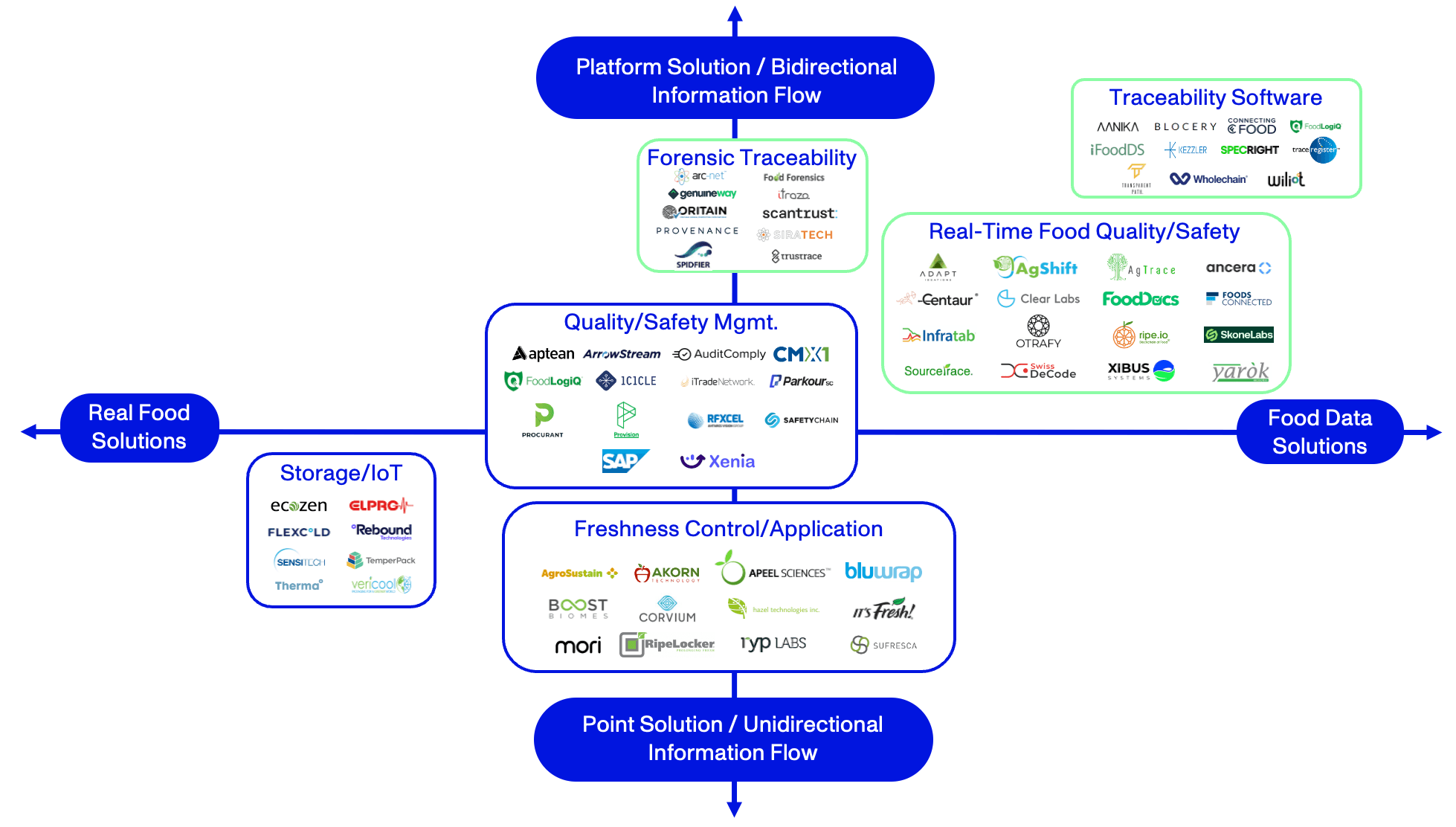Topic
Supply Chain & Logistics
Published
April 2024
Reading time
6 minutes
Food & Agriculture Traceability
A field of opportunity
Authors

Robert Lamprecht
Research Director
Food & Agriculture Traceability
Download ArticleResearch

Have you ever wondered where the coffee you’re drinking is sourced and if that process was ethical? Or whether a broken cold chain on your seafood’s journey could be the source of your illness? These and other considerations have driven both opinion and regulation, and suppliers across the globe will soon need to be able to trace a product’s passage from origin to point of sale to ensure safety and quality.
As a result, there are a plethora of new players in this space, all vying for a slice of this market—which is sure to be substantial, given that the global food safety testing market is estimated to reach $45 billion by 2032.1 The opportunities are vast—every operator in the chain is ultimately going to need a solution that allows them to comply with traceability standards and requirements.
Consumers demand transparency
Globalization, coupled with increasing free trade, brought affordable, diverse, and exotic products to market but also introduced safety and ethical concerns. Consumers and other stakeholders in the food supply chain were alarmed by outbreaks of food-borne illnesses such as E. coli and salmonella, safety hazards affecting produce such as BSE (mad cow disease) and avian influenza, as well as the use of unregulated chemicals and genetically modified organisms (GMOs). In addition, consumers worldwide are more concerned than ever about animal welfare, the ecological and environmental impact of food production, and ensuring fair trade.
Consequently, there is a growing demand for transparency in the way food is grown and processed, which has made “traceability” an important issue for both policymakers and players who can deliver solutions in this space.
Food and agriculture traceability seeks to track and trace consumable products through the supply chain, including origin, growth and input practices, processing, transport, and storage. Although primitive tracking examples existed, this practice began with the UPC barcode system developed in the 1970s and 80s. Technological advances revolutionized accuracy and transparency in this space, ushering in solutions like RFID (radio frequency identification) and GPS, which can trace the status and location of products, while blockchain prevents false reporting. Modern systems use this tech with cloud and IoT to enable real-time monitoring of movement and conditions. Some also use AI to control and monitor the production and circulation of products.
Driving the market
Several tailwinds are driving this market and giving impetus to these new solutions. These include the following:
- FSMA Rule 2042:2 This law requires end-to-end traceability of foods on the US Traceability List, which primarily includes perishable products and constitutes an estimated 20% - 30% of food consumed in the US).3 US companies must be compliant by January 2026, providing a major catalyst for agile solutions.
- Global Regulation: There is ongoing growth in regulation aimed at food safety, traceability, and governance, which is forcing companies to adapt.
- Cost of Food Poisoning and Food-borne Disease: An estimated one in six people in the US contract food-borne illnesses annually,4 with estimated costs ranging from $15.6 billion5 to more than $55 billion.6
- Consumer Expectations: Consumers care about ingredients, sourcing, production, and processing, and an estimated 71% will pay a premium for traceability.7
- Brand Reputation and Safety:8 Counterfeit goods have a substantial negative impact on brands, and the steady rise in counterfeit drugs and food fraud (misrepresentation of food-related products for economic gain) impacts consumer safety.
Market Map
The market map below shows where current players are active in the market and the sub-sector they’re operating in. We consider those dealing in food data and built off platforms with multi-directional information flow the most attractive, specifically in the areas of:
- Traceability software
- Real-time quality and safety detection
- Forensic traceability
Market Map
Food & Agriculture Traceability

Note that this market map is a work in progress. Our understanding of the market is rapidly evolving—if you have a differing view or want to share your perspective, please reach out!
Why we believe in traceability, real-time quality and safety detection
We’ve highlighted some exciting players in our chosen fields worth watching for investment opportunities. As regulations kick in, these will likely offer some very innovative solutions.
1. Traceability Software
Here, solutions can be vertical (a single producer’s process) or horizontal (across the product journey from farm to table), although the latter appears more successful. We prefer those who are specialists rather than adding traceability as part of an ERP solution.
- Connecting Food: This Paris-based company operates a food tech and blockchain platform based on blockchain technology that can integrate with clients' existing systems. Through digital twinning, it traces products batch by batch as they pass through production lines and audits them in real time, offering a live visibility dashboard.
- iFoodDS: Focused on the fresh foods industry, iFoodDS provides solutions in food safety, quality, and traceability. The company is well-established and FSMA 204 compliant. Systems offer visibility into the supply chain and aim to minimize waste and safety issues. Based in Seattle, iFoodDS has clients of varying sizes.
- Wiliot: Sticker-like compute devices called IoT Pixels that power themselves by harvesting radio waves are applied to products. The platform uses the cloud to create a digital twin, allowing users to comply with FSMA Rule 204 record-keeping obligations. The system helps to ensure traceability and compliance, eliminate waste and stock supply issues, and optimize availability. Based in Israel, with offices on four continents, Wiliot operates across food, apparel, and healthcare industries.
2. Real-time quality and safety detection
These technologies enable on-site detection of contamination. These are largely early-stage, stemming from new regulation. Here we favor innovative, real-time solution providers rather than legacy track and trace players.
- FoodDocs: A US-based company with a SaaS model, that allows companies to create and customize their food safety management system. FoodDocs helps customers maintain safety standards and comply with regulations, consolidates the processes used to manage food safety, and provides full chain traceability and recall-
- SwissDeCode: This Swiss start-up offers a variety of rapid onsite DNA detection solutions with automated contaminant detection without external laboratories. It allows companies across the food supply chain to detect contamination earlier, avoiding recall and reputation issues. This offering is scalable and relevant across the food value chain.
3. Forensic traceability
These technologies enable accurate tracing of raw material sources and product provenance through the use of data science. This area is underpenetrated and largely industry-specific.
- Oritain: Applies forensic and data science to verify the origin and authenticity of products and raw materials. Based in New Zealand, Oritain is focused on ensuring sustainability and brand reputation and reducing the risk of fraud and unethical practices. It provides SaaS-based tools to research the origin of commodities and as its customer base grows, so does its database of forensic data. It recently raised $57 million to continue building the business.
- Arc-Net: Built on blockchain technology, UK-based Arc-net offers solutions for food chain traceability and analytics. Specifically focused on distilleries and breweries as well as livestock, Arc-net generates storybook interfaces for customers to engage with a product’s journey.
In conclusion
This is a space that can only grow. Regulation in the US will hit soon and companies there will scramble to comply. The rest of the world will surely follow and anyone who can offer a cost-effective and agile solution will be in high demand.
Endnotes
[1] Precedence Research, Food Safety Testing Market, 2023
[2] U.S Food and Drug Administration, Food Traceability List, 2024
[3] BCG, The Time is Ripe for Food Traceability, 2021
[4] U.S. PIRG, How Safe is your Food, 2019
[5] Centers for Disease Control, CDC and Food Safety, 2023
[6] Ohio State University, High Cost of Foodborne Illness, R.Scharff, 2015
[7] IBM, Meet the 2020 Consumers Driving Change, 2020
[8] Library of Congress, U.S. Intellectual Property and Counterfeit Goods, 2020
The information contained herein is provided for informational purposes only and should not be construed as investment advice. The opinions, views, forecasts, performance, estimates, etc. expressed herein are subject to change without notice. Certain statements contained herein reflect the subjective views and opinions of Activant. Past performance is not indicative of future results. No representation is made that any investment will or is likely to achieve its objectives. All investments involve risk and may result in loss. This newsletter does not constitute an offer to sell or a solicitation of an offer to buy any security. Activant does not provide tax or legal advice and you are encouraged to seek the advice of a tax or legal professional regarding your individual circumstances.
This content may not under any circumstances be relied upon when making a decision to invest in any fund or investment, including those managed by Activant. Certain information contained in here has been obtained from third-party sources, including from portfolio companies of funds managed by Activant. While taken from sources believed to be reliable, Activant has not independently verified such information and makes no representations about the current or enduring accuracy of the information or its appropriateness for a given situation.
Activant does not solicit or make its services available to the public. The content provided herein may include information regarding past and/or present portfolio companies or investments managed by Activant, its affiliates and/or personnel. References to specific companies are for illustrative purposes only and do not necessarily reflect Activant investments. It should not be assumed that investments made in the future will have similar characteristics. Please see “full list of investments” at https://activantcapital.com/companies/ for a full list of investments. Any portfolio companies discussed herein should not be assumed to have been profitable. Certain information herein constitutes “forward-looking statements.” All forward-looking statements represent only the intent and belief of Activant as of the date such statements were made. None of Activant or any of its affiliates (i) assumes any responsibility for the accuracy and completeness of any forward-looking statements or (ii) undertakes any obligation to disseminate any updates or revisions to any forward-looking statement contained herein to reflect any change in their expectation with regard thereto or any change in events, conditions or circumstances on which any such statement is based. Due to various risks and uncertainties, actual events or results may differ materially from those reflected or contemplated in such forward-looking statements.
